The Brazos Performance Preview: AMD E-350 Benchmarked
by Anand Lal Shimpi on November 16, 2010 12:01 AM ESTMemory and Cache Latencies
The Brazos platform was configured with 4GB of DDR3-1066 memory. The IDF system had memory running at DDR3-1333, however AMD had to decrease clocks presumably to meet validation requirements for final silicon. I measured an 86.9ns trip to main memory, a 3 cycle L1 and a ~22 cycle L2 cache. That's a lower latency memory interface than Atom or Core 2 based processors, but a higher latency L2.
CPU Performance: Better than Atom, 90% of K8 but Slower than Pentium DC
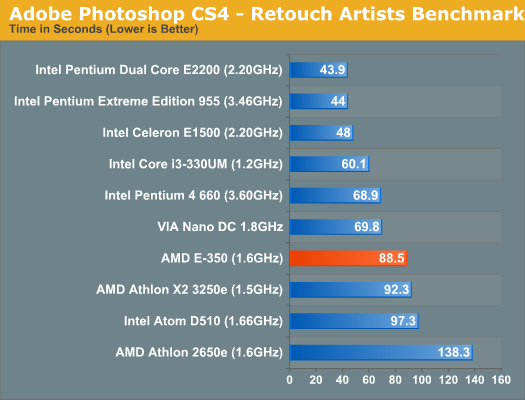
AMD's performance target for Bobcat was 90% of the performance of K8 at the same clock speed and our Photoshop CS4 benchmark shows that AMD can definitely say that it has met that goal. At 1.6GHz the E-350 manages to outperform a pair of K8s running at 1.5GHz in the Athlon X2 3250e. Unfortunately for AMD, Intel's Pentium dual-core running at 2.2GHz is much quicker. Most notebooks in the $400+ range have at least a 2.2GHz Pentium. Even the Atom D510 isn't far behind.
AMD tells me that in general purpose integer tasks, the E-350 should do well and it may even exceed AMD's 90% design target. However in higher IPC workloads, for example many floating point workloads, the E-350 is constrained by its dual issue front end. In these situations, the out of order engine is starved for instructions and much of Bobcat's advantage goes away.

Our x264 HD test has the E-350 performing within 86 - 92% of the Athlon X2 3250e, once again meeting AMD's design targets. Unfortunately, this isn't much faster than an Atom - mostly thanks to Atom's Hyper Threading support. Although not an out of order architecture, Atom gets a healthy efficiency boost by being able to execute instructions from two threads per core. Once again, compared to a 2.2GHz Pentium, the E-350 isn't close. Even VIA's dual core Nano is faster. When it comes to power consumption however, the E-350 can't be touched. I measured max system power consumption at 25.2W while running the x264 encode test. With the exception of the Atom D510, the rest of the desktop platforms here consume much more than that at idle (much less under load).
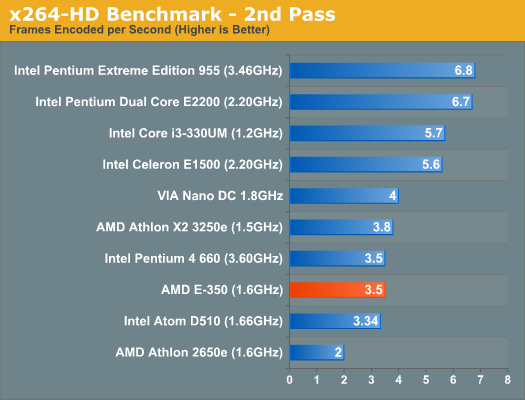
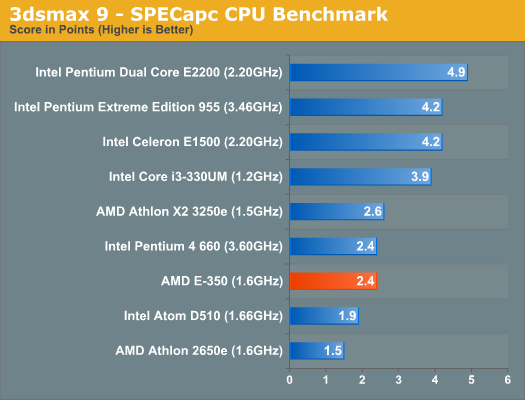
Despite being a offline 3D rendering benchmark, our 3dsmax 9 test does fall in line with expectations. The E-350 delivers 92% of the performance of the Athlon X2 3250e and outperforms the Atom D510 by 26%. Unfortunately for AMD, the Pentium dual-core holds onto a significant performance advantage here. Clock for clock, Bobcat won't be able to do much against anything Core 2 based. The real advantage here will be GPU performance.
Single Threaded Performance
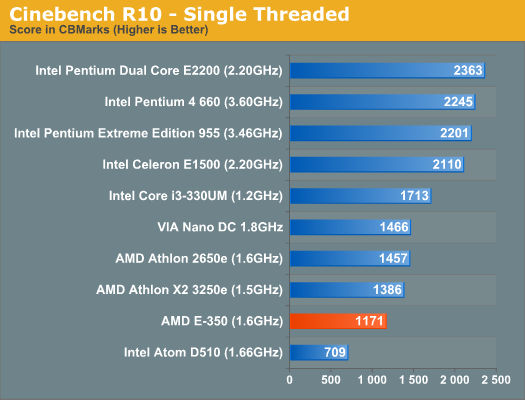
In most of our benchmarks the performance advantage over Atom isn't huge, yet using Brazos is much better than using an Atom based machine. It all boils down to one thing: single threaded performance. Atom can make up for its deficiencies by executing a lot of threads in parallel, but when you're bound by the performance of a single thread the E-350 shines. The E-350 is 65% faster than the Atom D510 in the single threaded Cinebench R10 test. It's this performance advantage that makes the E-350 feel so much quicker than Atom.
The Core i3-330UM manages a 46% performance advantage over the E-350. Even in the ultraportable Arrandale ULV space at lower clocks, AMD still leaves a lot of CPU performance on the table. The advantage here will be cost. A single E-350 is less than 40% of the die area of a Core i3-330UM. You may not get the same CPU performance, but performance per mm^2 is much higher.

In the multithreaded Cinebench test Atom is able to catch up quite a bit, but the E-350 still holds an 11% advantage.
File Compression/Archive Recovery Performance
Our final two CPU tests are both multithreaded and they show the E-350 equaling and falling behind the performance of the 1.5GHz Athlon X2. As we explained earlier, the gap between the E-350 and Atom shrinks as you add more threads to the workload.
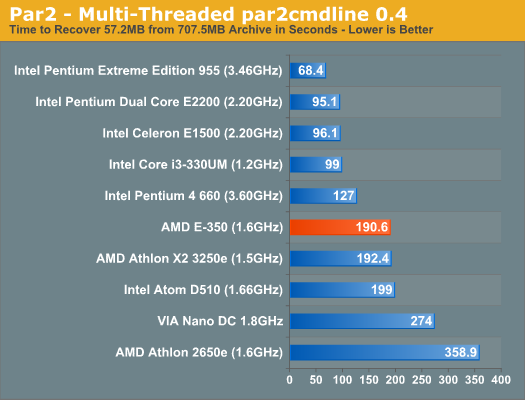
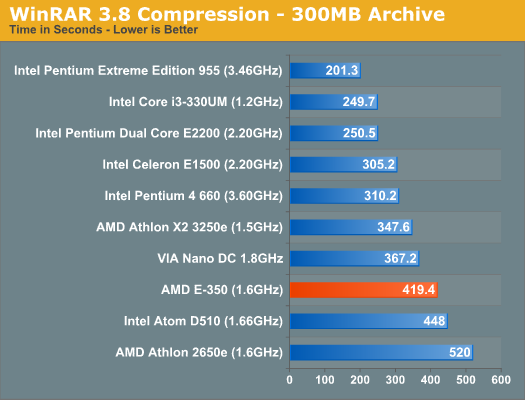










207 Comments
View All Comments
svojoe - Wednesday, November 17, 2010 - link
I'm sure it was not easy to do a full suite of testing, But I would *really* like to see the Brazos pitted against the ATOM/ION or the CULV/ION Platforms. Despite atom's really slow performance for the same price ranges even today I am still amazed that my single core ATOM (hp mini 311) paired with ION is hard to beat in the 11.6" and below form factor for multimedia and gaming at a sub $400 price tag.I know that I am a small niche in the market I want netbook/ultraportable form factors that are potent at gaming/multimedia that are also cheap. Can the Brazos answer in this category too or will the dual core ATOM/ION system's still rule when it gets down to raw cost and fps?
Cloakstar - Wednesday, November 17, 2010 - link
The chip may be memory bandwidth limited, but AMD was kind enough to demonstrate what now is best termed as a ~30% memory overclock at IDF. As long as the retail mobtherboards have even a few clock options, the raw TDP looks like it should provide a ton of headroom for the rest of the chip to clock up to consume that memory bandwidth.Brazos TDP: 21W ... Load power: 6.5W
"The Brazos platform was configured with 4GB of DDR3-1066 memory. The IDF system had memory running at DDR3-1333, however AMD had to decrease clocks presumably to meet validation requirements for final silicon."
"The Radeon HD 6310 in the E-350 does very well, despite the memory bandwidth limitations."
silverblue - Wednesday, November 17, 2010 - link
I put 2GB extra in my PC the other week and had to up a couple of the timings to make it work. I wonder how memory timings will affect the GPU's performance.Without a full rundown on what the system had, we won't know if AMD could've put better RAM in there, for example. I doubt they'd be sandbagging.
GeorgeH - Wednesday, November 17, 2010 - link
They're only a good value option because Intel doesn't care to offer their superior products with similarly thin profit margins.If Intel were to release a P4 for $0.50, it would be a fantastic value option for a lot of applications and users, but that doesn't change the fact that a P4 core is substandard when compared to a Nehalem core.
GeorgeH - Wednesday, November 17, 2010 - link
I wouldn't call it a myth so much as slightly disingenuous. Painting with a broad brush, there are two types of compute tasks - those that are arithmetically intense and those that aren't. Typically those that aren't are integer/boolean, and the rest are float. GPUs are great with most arithmetically intense operations, so they get conflated with float problems while leaving CPUs for the rest.It isn't completely precise to say CPUs are for integers and GPUs are for floats, as both can work with and excel at using either, but it's a good approximation when you start talking about real-world tasks a typical user will want to complete that take a significant amount of time to run.
krazyderek - Wednesday, November 17, 2010 - link
by the looks of things, AMD has made a good cut in power usage, at the expense of looking CPU competitive.Why don't they just release a E-460 with 3 bobcat cores at 1.6ghz, or 2 cores at 1.8ghz that will leave Atom in the dust and truly compete with i3 ?? looks like that would only take it up to ~27w which would be on par...
maybe it's just me, but when something new comes out, i don't care if just battery life has gone up, or any other one metric for that matter, i want to see better everything... battery life, graphics, and cpu, otherwise i just wait till the next generation when they've all been addressed.
sinigami - Wednesday, November 17, 2010 - link
uh, am i missing some charts on page 4 or something? because i only see three, and the zacate wins only the first one, ties on the second one, and loses on the third. With only one win, the headline should NOT say it's faster!you could say that the Clarkdale IGP wins or ties the zacate on two out of three gaming benchmarks, and declare it faster.
sheesh, is that some biasedness, or just wishful thinking?
StormyParis - Thursday, November 18, 2010 - link
you're testing games on this eminently non-gaming platform, but not video ?sinigami - Friday, November 19, 2010 - link
not just is it weird that they tested games, it's even weirder that they tested three games, and the headline said this platform was faster than intel's....WHEN IT ONLY WON ONE TEST!
did anyone else even read to page 4?
silverblue - Friday, November 19, 2010 - link
One thing to point out is that the i5-661 has a 900MHz GPU, the i3-530 a 733MHz GPU and the 890GX a 700MHz GPU. This particular flavour of Brazos is a mere 500MHz. Also, Anand is right in that, if most games are GPU bound, Brazos is easily superior to most integrated solutions and definitely so at the same GPU clock speed.